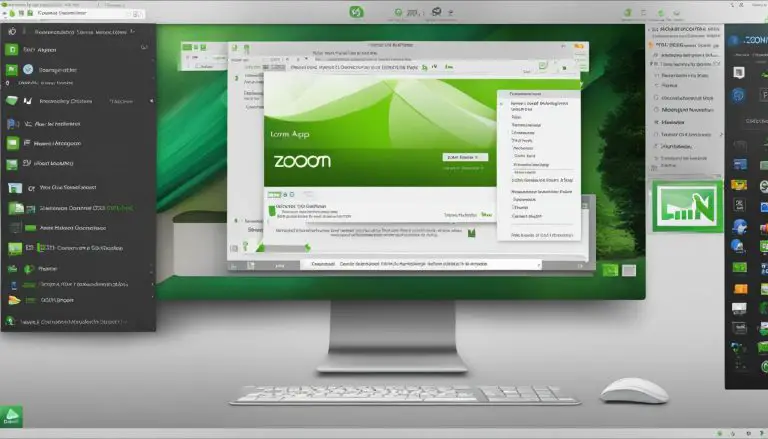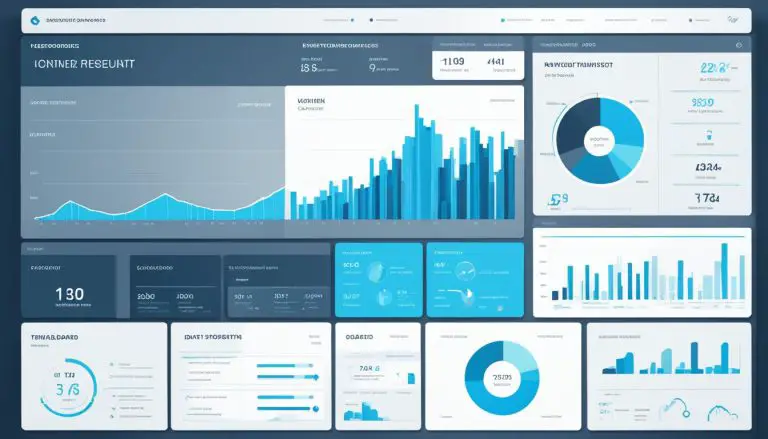Exploring RAIDz1 in ZFS: A Data Protection Guide
Welcome to my comprehensive guide on RAIDz1 in ZFS. If you’re looking to understand what RAIDz1 is, how it works in the ZFS file system, and the benefits it offers, you’ve come to the right place. RAIDz1 is a data protection feature that provides fault tolerance and redundancy, ensuring the safety of your valuable data. Let’s dive in and explore RAIDz1 in ZFS together.
Key Takeaways:
- RAIDz1 is a data protection feature in the ZFS file system.
- It offers fault tolerance and redundancy by distributing parity blocks across disks.
- RAIDz1 can tolerate the loss of a single disk but not multiple failures.
- It provides a good balance between data protection and storage efficiency.
- Understanding RAIDz1 is crucial for managing robust storage systems.
Understanding ZFS Structure: Zpools, Vdevs, and Devices
To understand ZFS, it is important to comprehend its structure. ZFS utilizes a hierarchical architecture consisting of zpools, vdevs, and devices. Let’s take a closer look at each component:
Zpool:
A zpool serves as the top-level construct in ZFS. It can be thought of as a container that holds one or more vdevs, creating a logical storage pool. Zpools provide the foundation for data storage and management in ZFS.
Vdev:
A vdev, short for “virtual device,” is a fundamental component of a zpool. A zpool can consist of a single vdev or multiple vdevs. Each vdev can further be comprised of one or more physical or virtual devices. Vdevs provide the basis for data redundancy and fault tolerance in ZFS storage configurations.
Device:
Devices refer to the actual storage entities that contribute to a vdev. These can include physical disks, partitions, or files. ZFS aggregates these devices within a vdev to create a consolidated storage resource.
ZFS provides redundancy at the vdev level, meaning that if a storage or special vdev fails, the entire zpool becomes compromised. Therefore, it is crucial to choose the appropriate RAID level for your zpool to ensure adequate data protection and fault tolerance. ZFS offers various RAID levels, such as RAID0, RAID1, RAIDZ1, RAIDZ2, and RAIDZ3, each providing different levels of redundancy and performance.
To summarize:
| ZFS Component | Description |
|---|---|
| Zpool | The top-level structure that holds one or more vdevs |
| Vdev | A fundamental element within a zpool, composed of one or more devices |
| Device | The physical or virtual storage entities contributing to a vdev |
Understanding the structure of ZFS and its different components is vital for efficient storage management and the implementation of robust data protection mechanisms.
Overview of RAIDz1 in ZFS
RAIDz1 is a specific configuration within the ZFS file system that provides robust data protection. It is based on diagonal parity RAID and offers a balance between storage efficiency and data security.
RAIDz1 in ZFS is designed to tolerate the loss of a single disk, making it resilient against hardware failures. Each data stripe in RAIDz1 is allocated a specific number of parity blocks, which determines the level of fault tolerance.
However, it is important to note that if more than one disk fails in a RAIDz1 configuration, the entire zpool will be lost. While RAIDz1 offers data protection against single disk failures, it is not suited for scenarios involving multiple disk failures.
The benefits of RAIDz1 in ZFS are twofold. Firstly, it provides storage efficiency by distributing parity blocks across the disks, allowing for an optimal use of storage space. Secondly, it ensures data protection by offering fault tolerance against single disk failures.
“RAIDz1 in ZFS provides a good balance between storage efficiency and data protection, making it a popular choice for ZFS storage setups.”
To better understand RAIDz1 in ZFS, it is helpful to visualize the configuration through a table:
| Disk | Data Stripe | Parity Blocks |
|---|---|---|
| Disk 1 | Data Block 1 | Parity Block |
| Disk 2 | Data Block 2 | Parity Block |
| Disk 3 | Data Block 3 | Parity Block |
The table above illustrates a simplified example of a RAIDz1 configuration with three disks. Each disk contains a data stripe with a corresponding parity block. In the event of a disk failure, the parity block can be used to reconstruct the lost data, ensuring the integrity of the zpool.
Benefits of RAIDz1 in ZFS
RAIDz1 in ZFS offers several advantages and benefits for data protection. One of the key benefits is fault tolerance. RAIDz1 allows the array to withstand the loss of a single disk, ensuring that even if one disk fails, the data remains accessible and recoverable.
Another benefit of RAIDz1 is its ability to balance storage efficiency and data protection. It utilizes diagonal parity RAID, distributing parity blocks across the disks. This approach optimizes storage space while ensuring data redundancy, maximizing the utilization of available resources.
“RAIDz1 in ZFS offers fault tolerance and storage efficiency, making it a popular choice.”
– Expert
The fault tolerance offered by RAIDz1 is especially valuable in protecting against hardware failures. By distributing parity blocks in a diagonal pattern, RAIDz1 minimizes the risk of data loss and ensures the integrity of the stored information.
Overall, RAIDz1 in ZFS provides a robust solution for data protection. Its benefits include fault tolerance, efficient storage utilization, and protection against hardware failures. These advantages make RAIDz1 a popular choice for ZFS storage setups, enabling organizations to safeguard their critical data and ensure business continuity.
| Benefits of RAIDz1 in ZFS |
|---|
| Fault tolerance |
| Efficient storage utilization |
| Protection against hardware failures |
Understanding Data Organization in ZFS: Datasets, Blocks, and Sectors
In ZFS, data is organized at different levels, providing a robust and flexible data management system. Let’s explore the key components of data organization in ZFS:
Datasets
Datasets in ZFS are similar to mounted filesystems and play a crucial role in organizing and managing data. Each dataset has its own set of properties, allowing administrators to define quotas, compression settings, and other storage-related configurations. By utilizing datasets, users can effectively partition their data, enabling efficient management and resource allocation.
Blocks
Blocks are the fundamental units of data storage in ZFS. They are stored on individual vdevs, which are made up of physical drives or partitions. ZFS employs a copy-on-write mechanism, where changes to data are written to new blocks rather than modifying existing ones. This approach ensures data integrity and simplifies data recovery in case of disk failures.
Sectors
Sectors serve as the smallest units of data storage on a disk. In ZFS, sectors are managed by the underlying hardware and are not directly accessible or configurable within the file system. However, understanding the concept of sectors is essential for evaluating disk performance and capacity planning.
ZFS Filesystem and Zvols
ZFS provides a powerful and feature-rich filesystem that allows for advanced data management capabilities. It supports features like snapshots, cloning, and data deduplication, making it ideal for various use cases. Additionally, ZFS introduces zvols, which are block devices without a traditional filesystem. Zvols offer a flexible and scalable solution for creating virtual storage volumes, enabling efficient utilization of storage resources.
In summary, ZFS offers a comprehensive data organization framework through datasets, blocks, sectors, and its versatile filesystem. With a deep understanding of ZFS’s data organization principles, administrators can effectively manage and optimize storage resources while ensuring data integrity and reliability.

| Data Organization Component | Description |
|---|---|
| Datasets | Similar to mounted filesystems, datasets allow for efficient data partitioning and management with customizable properties. |
| Blocks | Fundamental units of data storage stored on individual vdevs, supporting the copy-on-write mechanism for data integrity. |
| Sectors | The smallest units of data storage on a disk, managed by the underlying hardware and crucial for disk performance evaluation. |
| ZFS Filesystem | A powerful and feature-rich filesystem providing advanced data management capabilities, including snapshots and cloning. |
| Zvols | Block devices without a traditional filesystem, offering flexibility for creating virtual storage volumes. |
RAID-Z and Data Recovery in ZFS
RAID-Z in ZFS is a software-based RAID system that combines performance and data protection. It leverages dynamic stripes and checksums to detect and repair data corruption, ensuring the integrity of stored information. However, it’s important to note that while RAID-Z provides robust data protection, it cannot safeguard against all types of data loss, such as software malfunctions or user negligence.
In the unfortunate event of data loss in a RAID-Z configuration, data recovery can be challenging but not impossible. Various tools and techniques can help recover lost files, and one such tool is UFS Explorer Professional Recovery. This powerful software can analyze the metadata of RAID-Z configurations, assisting in the successful recovery of valuable data.
Proper analysis and understanding of RAID-Z metadata are crucial for effective data recovery. By delving deep into the metadata structure, it becomes possible to identify potential issues, locate missing files, and restore data from a RAID-Z system. With the right expertise and tools, data recovery in RAID-Z can be a viable solution for regaining access to important information.
It’s important for users to remember that data recovery from RAID-Z configurations requires specialized knowledge and experience. Therefore, seeking professional assistance or consulting reliable resources is highly recommended for the best possible outcome. With meticulous analysis and attention to detail, data recovery can turn a daunting task into a successful endeavor.
Conclusion
RAIDz1 in ZFS provides a reliable and efficient solution for data protection. With RAIDz1, users can achieve fault tolerance against the loss of a single disk, ensuring that their data remains accessible even in the face of hardware failures. The hierarchical structure of ZFS, combined with RAIDz1, allows for efficient storage management and data organization, providing a robust foundation for storage systems.
Understanding the structure and benefits of RAIDz1 in ZFS is crucial for designing and managing effective storage solutions. By utilizing RAIDz1, users can have peace of mind, knowing that their data is well-protected and resilient. The implementation of RAIDz1 in ZFS strikes a balance between storage efficiency and data protection, making it a popular choice for storage setups that require both reliability and performance.
In summary, RAIDz1 in ZFS offers a comprehensive data protection strategy, allowing for the recovery of data in the event of disk failures. By leveraging RAIDz1 and the inherent features of ZFS, users can ensure that their valuable data is safeguarded against potential risks. Embracing RAIDz1 in ZFS can ultimately contribute to a more secure and dependable storage infrastructure.
FAQ
What is RAIDz1 in ZFS?
RAIDz1 is a data protection feature in the ZFS file system that offers redundancy and fault tolerance. It is a type of RAID that uses diagonal parity RAID to distribute parity blocks across disks, allowing it to tolerate the loss of a single disk.
How does RAIDz1 work in ZFS?
RAIDz1 in ZFS uses diagonal parity RAID, where parity blocks are distributed across disks. It allocates one parity block per data stripe, providing fault tolerance against the loss of a single disk. However, if more than one disk fails, the entire ZFS pool is lost.
What are the benefits of RAIDz1 in ZFS?
RAIDz1 in ZFS offers fault tolerance by allowing the array to tolerate the loss of a single disk. It provides a good balance between storage efficiency and data protection by using diagonal parity RAID. This makes it a popular choice in ZFS storage setups.
How is data organized in ZFS?
In ZFS, data is organized into hierarchical structures. Datasets are similar to mounted filesystems and have their own set of properties. Blocks are the fundamental units of data storage, and sectors are the smallest units of data storage on a disk. ZFS also supports zvols, which are block devices without a filesystem.
What is RAID-Z in ZFS?
RAID-Z is a software-based RAID system in ZFS that combines performance and data protection. It uses dynamic stripes and checksums to detect and repair data corruption. However, RAID-Z cannot protect against all types of data loss, such as software malfunctions or user negligence.
How can data recovery be done in RAID-Z?
Data recovery from RAID-Z can be challenging but possible. Tools like UFS Explorer Professional Recovery can analyze the metadata of RAID-Z configurations and assist in recovering lost files. Understanding RAID-Z metadata is crucial for successful data recovery.
Why should I choose RAIDz1 in ZFS?
RAIDz1 in ZFS offers a reliable and efficient solution for data protection. It provides fault tolerance against the loss of a single disk, ensuring that data remains accessible even in the event of hardware failures. RAIDz1 is a popular choice for its robust protection and storage efficiency.
Further Reading
- https://www.ufsexplorer.com/articles/how-to/recover-data-zfs-raid-z/
- https://www.truenas.com/community/threads/assessing-the-potential-for-data-loss.111095/
- About the Author
- Latest Posts
Mark is a senior content editor at Text-Center.com and has more than 20 years of experience with linux and windows operating systems. He also writes for Biteno.com






